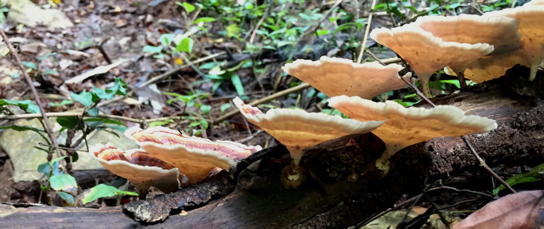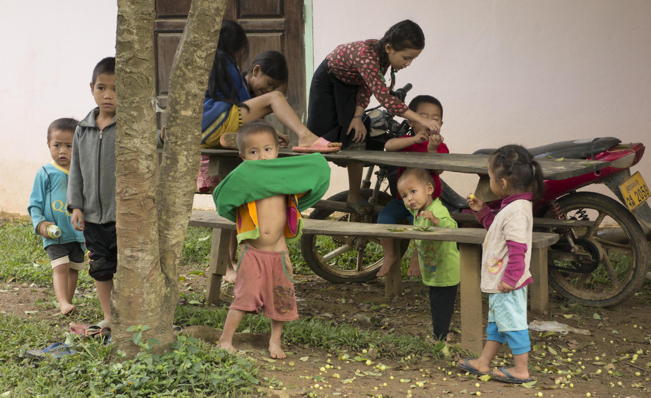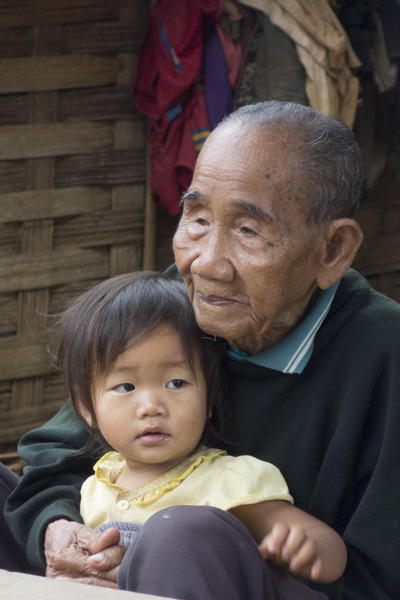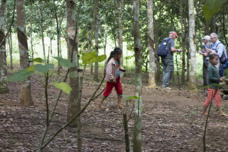

|
| Tree mushrooms that we saw on our walk, shortly after noon. |
«Breakfast, time for tooth-brushing», says my journal, which then continues: «and the start of a long hike that turned out to be much more demanding than any of us expected, and somewhat more adventure-filled as well. But before the trail proper, we walked through a couple of villages, poor and happy, it would seem, and the tiny children cuted it up for us shamelessly.»

|
| Shameless! (There’s an even cuter, larger version, too.) |
As you can read in Mark’s page, the first village was of Khmer people, by far the majority ethnic group of Cambodia but about 30% of the population of Laos; the second village was of Hmong people, who make up about 10% of this country’s population. They’re much more familiar to us in the States, especially if you live in Providence or the Twin Cities.

His great-great-granddaughter. I think
Mark’s
version of this picture
is better. You can get an
enlargement of this one, too.
But we left the villages and started our hike. Let me quote my journal here: «There had been rain the previous day, and the trail was muddy throughout. Up and up and up, with tricky footing, lots more ups and downs, and then the down and down and down was slippery, with loads of rocks threatening ankle-turn or leg-break.
«In addition to Hung and Toby, there were two young local men, one in sandals, the other (I think) in flip-flops. One of these was water-porter to the group, and both were ready to lend a strong and balancing hand to anyone in need. And I was frequently thus in need.

Harvesting rice (bigger version).

In a rubber plantation (bigger version).
«About 2/3 of the way through the walk, Sheri discovered a leech on her wrist, and was horrified. From then on till the end, people were either seeing the signs of having been sucked at, or picking the things off themselves. Mark and I gave ourselves a cursory search, and saw no problem. We continued confidently to the end, but to relax, Mark took off his shoes and found a 2-inch blot of blood on his sock. We already knew that the beasts’ mouthparts could go through a thick sock, so we were not surprised. In many of the other cases, there had been no sign of the leech, beyond the mischief it had done. But Mark did see the villain causing at least one of the two wounds he got. Blood was still oozing out of the puncture, and M had to hold a piece of tissue with antiseptic on it, for more than a minute.
«But then I took off my own shoes, and from the left ankle down, the sock was soaked in blood: far more bleeding than Mark had experienced, and the blood was even soaking the inner sole of my shoe. When I took the sock off, blood was not merely oozing, but flowing in a stream down the heel. I called Toby over; he wiped the wound with alcohol, and similarly to Mark, he gave me tissues and cotton wool with antiseptic to hold against the would till it should be stanched. Mark pointed out that the leech’s anticoagulant would have to be bled out of the wound before bleeding would stop. After I had held the tissue to my ankle for at least 5 minutes, the bleeding was still going on. I made do by using the multiply folded elastic of the sock to apply pressure so I could put the shoe back on.»
But some comments on the pictures in the block of twelve to the right:
Poinsettia is native to Mexico, but it obviously grows perfectly well here in Laos. It seems pretty clear that these plants are growing wild. The rubber tree is not native to these parts, either, but Southeast Asia is now the principal supplier of latex to the world. In Brazil, where the trees come from, the plant is subject to various blights, but not here. And another botanical note: the purple flowers shown to the left look to me like typical blossoms of the family Bignoniaceae—if you’re from the East, you know Catalpa and Trumpet Creeper in the family, and if in Southern California, you know Jacaranda and Tabebuia, though these two are introduced from South America.
|
In the morning, Toby explains some details of Laotian household construction (23 seconds) |
After our adventure with the leeches, the day changed quite a bit, and I’ve set those events into another page.